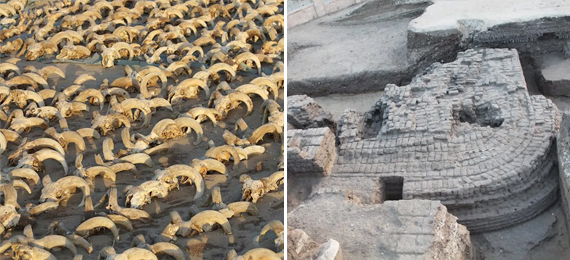
Apart from its rich vegetation, Egypt is famous for its ginormous pyramids and Magnifying Mummies.
Recently New York University archeologists exhumed mummified dogs, gazelles, rams, goats, cows, and mongooses. Nearly, 2000 skulls were uncovered from the sacred place belonging to the old dynasty.
A Brief History of Abydos
Abydos is considered one of the oldest and most important archeological sites in Egypt. It is occupied on the west bank of the Nile, in Upper Egypt. The sacred city of Abydos was the site of many Egyptian temples including Umm El Qaʻāb and it happened to be a burial ground for early Egyptian pharaohs for entombment. Years later it was turned into the Worship center of Osiris, the god of the underworld. Abydos had contributed more historical monuments than any other sites. Be it valuable inscriptions, funerary monuments, or linguistic development.
Where is Abydos in Egypt?
- A. The western Desert
- B. Upper Egypt
- C. Lower Egypt
- D. The Sinai Peninsula
Ramses II, who was best known for his remarkable reign and architecture constructed the temple of Seti accompanied by pharaoh(his father) Seti I. The temple owns an inscription from the 19th century known as the Abydos King list.
In 2019, Ramses II hit the headlines, as a massive Sphinx weighing 13 tons (11.8 metrics) was uncovered after it is hidden away for more than a century.
Additionally, the latest discovery in Abydos showcased more information about the beloved King Ramses II and his achievements.
Massive Discovery of 2000 Mummified Ram Skulls
Around 2000 mummified ram skulls dated back to the Ptolemaic period were unearthed from the sacred place i.e. temple of Ramses II in Abydos, southern Egypt. According to the Tourism and Antique Ministry, the ram skulls were severed for votive offerings in order to show reverence to Ramses II, 1000 years after his death.
The temple was constructed in honor of Ramses II, an Egyptian pharaoh who was the third ruler of the nineteenth dynasty. Notably, Ramses was famous for his long reign of over 66 years and for making alliances with neighbors. He was referred to as a “great ancestor” by his descendants and Egyptian people.
Mummified dogs, goats, ewes, wild goats, cows, gazelles, and mongooses were discovered in the ground along with the ram heads.
To add up, this exploration would help expand knowledge about the historical significance of the Ptolemaic period.
The astonishing temple was discovered 150 years ago, however, it does not contain his remains. Also, the temple features pillars bearing the depiction of Osiris, the Lord of the Underworld.
Furthermore, the excavation at the temple uncovered a large palatial construction with walls approximately 5 meters thick. The unknown structure dates to Egypt’s sixth dynasty(circa 2323 B.C. to 2150 B.C.) which anticipates Ramses II by roughly 1,100 years.
The uncovered structure would be the guide for further excavation and it will support re-establishing the sense of the ancient landscape of Abydos. Furthermore, the team discovered several papyri, statues, remnants of ancient trees, leather clothes, and shoes.
Head of Egypt’s Supreme Council of Antiquities, Mostafa Waziri stated that this discovery will help the audience gain more knowledge about Ramses II and the instances which took place around 2374 and 2140 B.C.